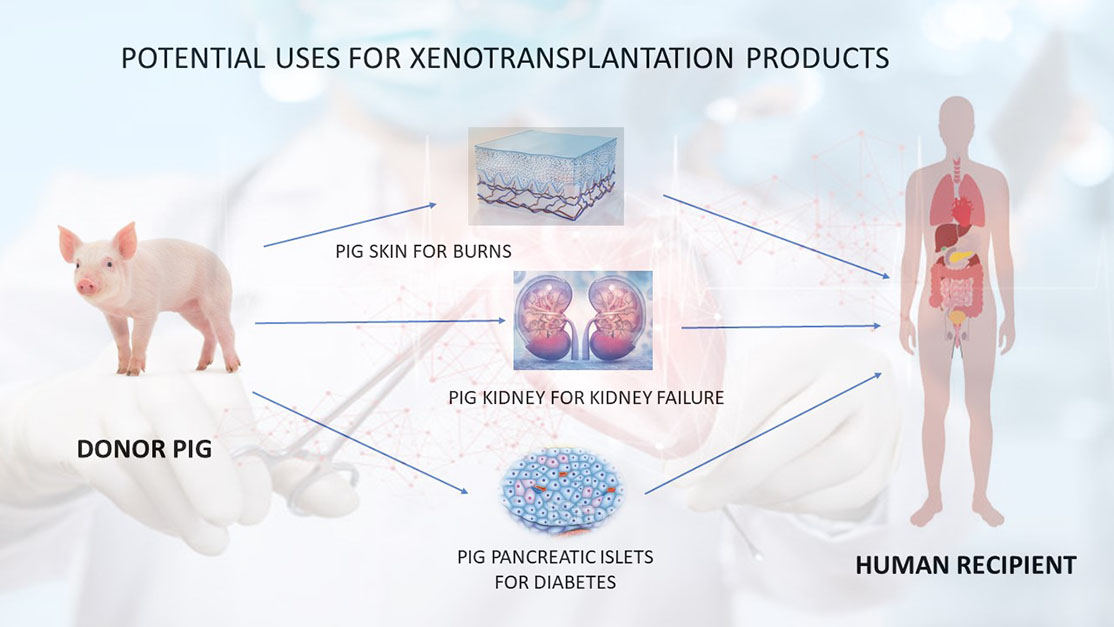Important Facts For Prelims
Xenotransplantation
- 14 May 2024
- 6 min read
Why in News?
Recently, the first recipient of a modified pig kidney transplant passed away after his groundbreaking xenotransplantation surgery. His death was not linked to the transplant.
What is Xenotransplantation?
- Definition:
- According to the US Food and Drug Administration (FDA), "Xenotransplantation is any procedure that involves the transplantation, implantation or infusion into a human recipient of either live cells, tissues, or organs from a nonhuman animal source, or human body fluids, cells, tissues or organs that have had ex vivo contact with live nonhuman animal cells, tissues or organs.
- Purpose: The primary aim is to address the shortage of human donor organs.
- For instance, in the United States, nearly 90,000 people are waiting for a kidney transplant, with over 3,000 dying annually while still waiting.
- Historical Context: The practice dates back to the 1980s, with the heart being one of the first organs attempted for transplantation from animals to humans.
- Procedure: In xenotransplantation, the animal organ selected, such as a pig kidney, undergoes genetic modifications to improve its compatibility with the human body.
- This involves using gene-editing technologies like CRISPR-Cas9 to remove certain pig genes that produce sugars with antibodies our immune systems react to and adding human genes to improve the organ's compatibility.
- Complications in Xenotransplantation:
- Organ Rejection: Preventing the human body from rejecting the pig organ is a significant challenge. Techniques such as embedding the pig’s thymus gland with the kidney help reduce immune responses.
- Infection Risks: The FDA highlights concerns about potential infections from both recognised and unknown infectious agents, which could spread to close contacts and the general population.
- Retroviruses: There is a risk of cross-species infection by retroviruses, which may remain latent and cause diseases years after infection.
- Xenotransplantation in India: In 1997, a surgeon in Assam, performed a xenotransplantation procedure by transplanting a pig's heart into a human patient.
- Unfortunately, the patient passed away a week later, leading to legal repercussions.
CRISPR-Cas9
- It is a revolutionary technology that allows scientists to modify the genome by adding, removing, or altering sections of the Deoxyribonucleic Acid (DNA) sequence.
- It consists of two key molecules, an enzyme called Cas9, which acts as molecular scissors to cut the DNA, and a piece of RNA called guide RNA (gRNA) that guides Cas9 to the right part of the genome.
- The guide RNA is designed to bind to a specific sequence in the DNA, allowing the Cas9 enzyme to make a precise cut.
- This triggers the cell's DNA repair machinery, which can be used by scientists to introduce changes to the genes in the cell's genome.
- Emmanuelle Charpentier and Jennifer A. Doudna recieved the 2020 Nobel Prize in Chemistry for finding a powerful tool in gene technology called CRISPR/Cas9.
Why are Pigs Often Used for Xenotransplantation?
- Historical Use: Pig heart valves have been used in human surgeries for over 50 years.
- Similarity to Humans: Pigs have anatomical and physiological similarities to humans. Their widespread farming makes them a cost-effective and accessible source.
- Size Matching: Various pig breeds offer a range of organ sizes, which can be matched to the specific needs of human recipients.
UPSC Civil Services Examination, Previous Year Questions (PYQs)
Prelims
Q1. With reference to agriculture in India, how can the technique of ‘genome sequencing’, often seen in the news, be used in the immediate future? (2017)
- Genome sequencing can be used to identify genetic markers for disease resistance and drought tolerance in various crop plants.
- This technique helps in reducing the time required to develop new varieties of crop plants.
- It can be used to decipher the host-pathogen relationships in crops.
Select the correct answer using the code given below:
(a) 1 only
(b) 2 and 3 only
(c) 1 and 3 only
(d) 1, 2 and 3
Ans: (d)
Q2. Consider the following statements: (2022)
DNA Barcoding can be a tool to:
- assess the age of a plant or animal.
- distinguish among species that look alike.
- identify undesirable animal or plant materials in processed foods.
Which of the statements given above is/are correct?
(a) 1 only
(b) 3 only
(c) 1 and 2
(d) 2 and 3
Ans: (d)





